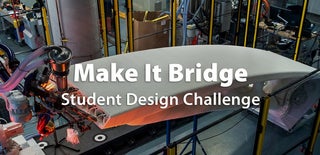Introduction: Brick Pedestrian Bridge
Richard 11th grade
Austin High School
Pedestrian bridges have come in all shapes in sizes throughout the centuries, ranging from sleek modern designs to more archaic stone and wood styles. I choose something that fit somewhere in the halfway point -brick- along with a few modern touches in the name of convenience. This can prove to be a more accessible version of the bridges in my local park with arched walkways than can be difficult for those with poor mobility.
Supplies
This miniature is printed using a Ender3-V2 printer and produced using Fusion 360. Though sanding is recommended, it is not needed.
Step 1: Bridge Profile
We start off with the most tedious part- making the bricks along with the profile view and making the gate that will eventually allow water to run through the bridge. Bricks are made in a small match initially but then expanded upon themselves using the rectangular pattern tool until a sufficient section is made to paste throughout the view. Measurements are re-applied as needed. A circle with the radius of 1.6 is used to make the arch in the center. Also note that sizes below .03 inches may not be very noticeable.
Step 2: Bridge Profile Clean Up
Larger bricks are made in the middle to fix discontinuity in the pattern and extra bricks are trimmed from the arch or ignored in extrusion.
Step 3: Profile Extrusion
Extrude out the profile view, the design sheet can be referenced for the exact measurements of the extrusions. Remember to keep the bridge at half width after initial extrusion so that it can be mirrored properly to the other side.
Step 4: Top Sketch
Design railing posts for the top the outside posts are .32 in length while inside ones are .16 in length, both are the same width. Rectangular patterns are used to make the sidewalks blocks, they are made with slight grooves in between them that extend all the way to the bike path in the middle. Make sure that these grooves don't reach the bricks on the bridge as they can interfere with them. Mirror sketch over to opposite side of the bridge.
Step 5: Top Extrusion
Extrude the posts, raise the sidewalk blocks, and fillet the central paths curb by .04 inches. The grooves will need to be raised half as much as the actual side walk in order to create separation from the central path.
Step 6: Railings
Use rectangles and extrude out the top and bottom part of a railing that is connected between the posts, make sure to leave ample space in between. Design a half-vase like shape using the spline tool and use the revolution tool to create full 360 degree railing . Use the joint tool to place it in the center of a space and duplicate the body 4 more times to create the railing support. After this, use the rectangular pattern tool again to finish it for one side and mirror the railing to the opposite side.
Step 7: Terrain
Create a large flat box using the form tool, it needs to be twice as wide wide than the bridge and just as long. Use faces slider to create the extra sides needed to make the ground shape. After the initial form is finished, use the form modify tool to pull up faces near the outside and raise the ground near the walkway, this will create a pond shape on both sides while making the bridge more integrated with the surrounding terrain.
Step 8: Trees
For the second and last form, add a quadball and double the amount of faces on each side. This should create a "+" shape in the center with a point, pull this point down on each face by .02 to create a slight conical shape. Do the same with the top by a positive .2 to create a point. Go back into regular solids menu and create a small circle touching the underside the treetop with a .428 diameter, create an offset of it by .2 for a second circle of .628. Extrude the smaller circle a length of .8 downwards. Extrude both the larger ring and smaller circle to create a hole with tolerances in the terrain around the bridge. Replicate the hole until there are 3 evenly placed on each side
Step 9: Extend Path and Finish
Extend the flat faces of the bridge to extend the path to the edge of the terrain. And use the pattern tool to extend the sidewalk to this full length.
Attachments

Runner Up in the
Make It Bridge













